The Seven Ages of Man (painting series)
The Seven Ages of Man is a series of paintings by Robert Smirke, derived from a monologue from William Shakespeare's As You Like It, spoken as the melancholy Jaques in Act II Scene VII. The phrase begins as all the world's a stage. The stages referred are: infant, schoolboy, lover, soldier, justice, pantaloon and old age.[1][2][3][4][5][6]
Painted between 1798 and 1801, they depict the journey of life in its various forms.[7] They were produced for the Boydell Shakespeare Gallery,[8][9] and engravings by Peltro William Tomkins, John Ogborne, Robert Thew, Peter Simon the Younger and William Satchwell Leney based on Smirke's paintings were included in the gallery's folio edition of Shakespeare's work.[10]
Background
In 1796, Robert Smirke agreed to paint William Shakespeare's The Seven Ages of Man for John and Josiah Boydell's Shakespeare Gallery.[11]
The seven ages
The character Jaques expresses the ages as the following stages:
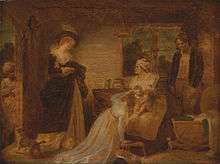
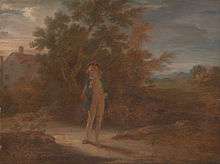

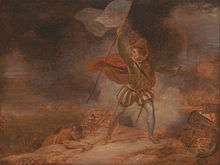
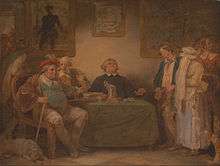
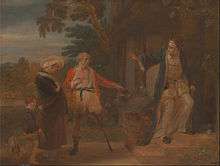

The Infancy
Just after being born, he is an innocent baby; all the while wailing and crying like a baby.
The Schoolboy
Here, he begins his schooling; the charms of helpless innocence cease. It is in that stage of life that he begins to go to school. He is unwilling to leave the protected environment of his home as he is still not confident enough to exercise his own discretion.
The Lover
The lover is depicted as a young man composing his love poems, shown beneath two pictures of Cupid, the god of love and on the left, Romeo-Juliet balcony scene. In this stage, he is always maudlin, expressing his love in a fatuous manner. He makes himself ridiculous in trying to express his feelings. The child in this stage, cares for its beloved the most and is quite concerned about it and is ready to sacrifice its life also to show its affection towards it.
The Soldier
Here, he is hot-blooded with a high degree of self-respect. He looks forward to gaining a reputation, even if it costs him his life. He is inflamed with the love of war and, like a leopard, he charges. He is very easily aroused and is hot headed. He is always working towards making a reputation for himself, however short-lived it may be, even at the cost of foolish risks.[12]
The Justice
In this stage he thinks he has acquired wisdom through the many experiences he has had in life and is likely to impart it. He has reached a stage where he has gained prosperity and social status. He becomes vain and begins to enjoy the finer things of life and he attains a socially accepted state and expounds the wisdom he has gained in his life.[12]
The Pantaloon
He is a shell of his former self — physically and mentally. He begins to become the butt of others' jokes. He loses his firmness and assertiveness, and shrinks in stature and personality and tries to shrink himself into a shell of his worries and is indifferent to his physical appearance and apparel, just as he was in his youth.[12]
The Old Age
In this stage he is Dependent on others for care and unable to interact with the world, he experiences "second innocence, and mere oblivion. This stage is also known as second infancy."[13]
References
- "Robert Smirke (1752–1845)". Dictionary of National Biography, 1885–1900. 52.
- "The Seven Ages of Man The Infant from Act II, Scene vii of As You Like it by William Shakespeare c.1798–1801". 1st Art Gallery Inc. Retrieved 15 January 2015.
- "Peltro William Tomkins & Robert Smirke: As You Like It (The Seven Ages of Man: The First Age)". Art of The Print. Retrieved 15 January 2015.
- Rusche, Harry. "Shakespeare Illustrated, The Artists: Robert Smirke, 7. The Seven Ages of Man". Emory University. Retrieved 15 January 2015.
- Highfill, Philip H.; Burnim, Kalman A.; Langhans, Edward A. A Biographical Dictionary of Actors, Actresses, Musicians, Dancers, Managers, and Other Stage Personnel in London, 1660–1800. 14. p. 129.
- Ritchie, Fiona; Sabor, Peter. Shakespeare in the Eighteenth Century. p. 245.
- Thomas R. Cole. The Journey of Life: A Cultural History of Aging in America. p. 24, note 64.
- International Shakespeare Association. Congress (1986). Images of Shakespeare: Proceedings of the Third Congress of the International Shakespeare Association, 1986. International Shakespeare Association. Congress. p. 122.
- Wigston Smith, Chloe. Women, Work, and Clothes in the Eighteenth-Century Novel. p. 56.
- Friedman, Winifred H. (1976). Boydell's Shakespeare Gallery. New York: Garland Publishing Inc. pp. 203, 211.
- Ayres, James. Art, Artisans and Apprentices: Apprentice Painters & Sculptors in the Early Modern British Tradition. Oxbow Books. p. 17.
- Evans, John. The progress of human life: Shakespeare's Seven ages of man. p. .
- Routledge, G. (1867). The Shakespeare Gallery.
Attribution
![]()